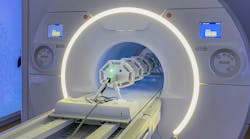Radiology-lab supply specialist PDC Facilities has developed a disinfection system based on ultraviolet (UV) LEDs that can be used in any scanner with a bore and patient table including MRI (magnetic resonance imaging), CT (computerized tomography), and similar systems. The UV-C LED Bore Sanitization System disinfects the bore — the cylindrical tunnel in which the scan is done — and the table on which the patient lies, requiring about six minutes for setup, scan, and takedown, enabling disinfection between patients. The UV-C LEDs radiate at 275 nm from multiple circular wheel-like structures that ride into the scanner bore on the patient table and that can kill many pathogens including deactivating the SARS-CoV-2 virus that causes COVID-19.
As we have covered UV-C systems increasingly with the coronavirus pandemic still surging, in many cases legacy mercury-discharge lamps have been the preferred source of the UV-C energy both because those lamps deliver more flux or output radiant power and also cost less. But there are some systems in which lamps just aren’t a good choice. We covered this ground in a recent column on the top ten questions surrounding UV-C and disinfection.
In the radiology application, legacy lamps would not be a good choice for several reasons. The UV-C LEDs are mounted to a frame on circular structures that are connected somewhat akin to wheels on an axle. The LEDs radiate outwardly from the perimeter of each wheel and reach all of the bore and table surfaces. Moreover, the PDC system is designed to be operated and quickly moved to the next task and requires constant power on/off cycles that would shorten the life of and incur warm-up times required by mercury lamps.
We have regularly pointed out the need for safety with UV-C-based disinfection systems. PDC says that so long as the operator remains at the cart, 3 ft or further from the scanner, the UV-C LEDs should pose no danger. We’d add that such radiology rooms operate with inherently dangerous equipment, are highly secure, and have shielded control rooms to which workers can retreat to during disinfection cycles. Personnel can still wear safety glasses and other gear if such steps are deemed necessary. And a lock and key are used to gate use of the control equipment.
[Update: PDC says that configuration and specifications are subject to change during compliance, regulatory review, and testing for ETL, CE, and CSA marks. The performance of the system will not be diminished.]
There has also been much discussion about whether UV-C will definitively deactivate SARS-CoV-2. PDC says yes based on its research. Our most authoritative work on that topic came from research at the Boston University (BU) National Emerging Infectious Diseases Laboratories (NEIDL). The answer to the question is that it depends on dose of radiation, and dose in this instance involves radiant power of the source, distance from the source to the virus in air or on a surface, and time of exposure.
PDC says that its system delivers a dose of 40 mJ/cm2 throughout the bore and table. PDC also plans to offer dosimeter (light measuring device) dots that can be placed in a scanner to verify the dose. “These dots can be placed on the table and in the bore prior to starting the sanitization cycle,” said Michael Hemmerly, chief sales office at PDC. “At the end of the cycle, the dots will indicate whether the proper dose has been administered.” He said PDC research showed that 99.9% of all pathogens would be deactivated with a disinfection cycle.
The actual disinfection operation takes three to five minutes so technicians can perform other duties during that cleaning cycle. “By now, many of us are all too familiar with the downsides, uncertainty, and at times, anxiety associated with conventional chemical sanitizers,” said Jim Maslowski, PDC co-founder and president. “The goal of PDC’s UV-C technology is to help healthcare providers more quickly and easily deliver the safest imaging experiences to patients.”
Ironically, the bore sanitization system did not arise specifically from the pandemic, but prior to COVID-19 as medical facilities sought to eliminate healthcare associated infections (HAIs). “As with most of PDC solutions, the creation of the UV-C solution was a collaborative effort,” said Maslowski. “While our current offering can sanitize any imaging bore and table, the original idea was a device to sanitize just one system type — a design for MRI, and one for CT, for example. Feedback from a variety of our customers, partners, and healthcare professionals helped guide product development in the most beneficial direction. We are grateful to have the support and insight from our customers and industry partners.”
For now, PDC is still testing prototypes of the systems and taking orders for deliveries beginning next month.
For up-to-the-minute LED and SSL updates, why not follow us on Twitter? You’ll find curated content and commentary, as well as information on industry events, webcasts, and surveys on our LinkedIn Company Page and our Facebook page.





